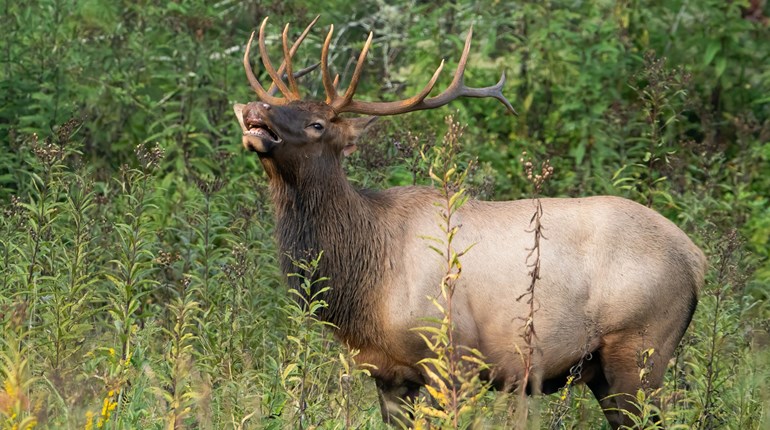
Secure in the distance, elk grazed in a mile long park of grass. A few young bulls stood among the 60-some elk, and every so often one of them turned sideways to reveal spikes or a set of spindly antlers. More elk stood inside the forest edge at the top of the mountain, a good distance from the herd. My binocular showed six bulls wearing a full head of six-point antlers. Dawn gave way to day and the bulls melted back into the lodgepole timber.

It was November when I saw those bulls. The fat the bulls had gained during the easy summer had been depleted during the September rut. If the bulls were going to survive the deep snow and cold of the coming winter they had to convert as much grass into calories as possible, and do it with the least expenditure of energy. However, herds of cows and calves are competition to bulls for forage. The noise and visibility of herds also alert predators. Because his antlers and pale hide contrast with the long black hair on his necks and undersides, a bull stands out in a herd and is more likely to become a predator’s target, whether a wolf, bear or hunter with a rifle. So the mature bulls go off by themselves, sometimes alone or together in twos and threes or more, to escape the hustle and bustle and increased danger of large herds.
Here are four tips to hunt these big bulls after the rut from finding where they live, to taking up their track and making a final approach.
In the Open
Because bulls tend to bunch up, every bull on a mountain might be in one place. So a hunter must cover lots of ground. To narrow the search, forget about easy access near open public roads. Figure a 45 minute hike from a road is the start of elk country. A hunting spot, though, need not be miles from a road. A river or steep canyon is enough of a barrier to most hunters. Pay attention to niches. The head of a foothill creek a ridge or two over from a road makes a quiet hideout for elk to sidestep hunters driving up the road to typical elk country.

A binocular is better than a horse for searching country. Glassing the forest edge during the first and last hours of the day is a good start. If there’s snow, look for lines of tracks. Pick a high point when glassing. For one it provides a vantage point. Second, it puts you above feeding elk and elk nearly always head uphill to bed for the day. As the elk move up the mountain, a hunter can note their route and move across the slope quickly enough to intercept them. However, check to make sure the night’s cold air is still not flowing down slope to carry a warning to the elk.
But don’t be disappointed if bulls remain hidden. Elk commonly leave the open before first light. In the evening elk may travel several miles from where they bed to where they feed so they might not arrive in the open until after dark.

In the Doghair
Bulls reach maturity by staying out of the wide open and a hunter’s rifle sights. One November I cut three sets of large tracks in the timber and followed along. The elk stopped here and there to browse on the rough leaves of beargrass that contained little forage value. Yet the elk ignored an open park of nutritious blue bunchgrass only a few hundred yards away, selecting security over sustenance.

If the bulls won’t come out, you have to go into the doghair thickets after them. I once read elk produce one calorie of heat for every calorie they convert to fat. To dissipate that heat during the early fall bulls stay at higher elevations in shaded north and east-facing slopes. These thickets limit visibility and the forbs and browse that grow beneath the heavy canopy remain green and moist well into the fall. Add a bog, spring or stream and these places are elk heaven.

I always head to these places early in the fall. The air holds the sweet scent of ferns and the chill of a trickle of water. As forbs freeze and dry out later in season bulls feed on sunnier slopes, but head back over ridgetops to bed in the thickets.
Tracks Tell on Elk
While hunting through the forest I watch the ground for elk tracks nearly as much as head through the trees for elk. My pace keeps up until the sharp edge of prints appear in the dirt of a trail or in the snow. A mix of medium and small tracks usually mean cows and calves. It pays to look off to the sides of these tracks because a bull may be traveling with the bunch, but because of its skittish nature, hangs back in cover. A four-inch wide print means a bull to me. Five inches is a huge bull. A .338 magnum cartridge fits in a track like that with almost an inch to spare on each side. A large lone track or several or more sets of large tracks together usually means bulls.

Elk are passing through the country if their tracks are lined out and only deviate direction to follow contours of the land to retain their elevation. Elk are looking for a place to bed for the day once their pace slows. To find that perfect spot to bed bulls split off from each other, wander some, stop and walk back on their track. Often, for no apparent reason, a bull will head downhill. Bulls are very aware predators follow their tracks. They head downhill, then loop back up to bed where they can watch down on their backtrack. The hunt is over if you follow the downhill track.
Final Approach
Many hunters prefer to stop this far along the track. They figure jumping a bull out of its bed spooks it so much it will run completely out of the country. Instead they wait, hoping the elk will come back out that evening. If you’ve come this far, I say keeping going.
Bulls in their beds remain alert. They may nod off, but keep one eye and both ears open because they are vulnerable stationary in their beds, and their tracks and scent give predators a line to them.

I shot a big bull by shadowing its track one hesitant step at a time. Four sets of large tracks headed into a thicket of short fir trees crisscrossed with waist-high deadfall. After a ways, the tracks wandered off one by one. I stayed above the last trail. One after another I sat on deadfall logs and swiveled my legs over to cross. Snow sluffing off branches broke the silence every so often. A rhythm developed of taking a few steps, stopping, looking and listening. A brown branch caught my eye. The branch swiveled and changed into an antler. The antler raised as a six-point bull stood up. The scope of my .338 wobbled across the bull. The crosshairs stopped for a moment. The rifle fired. The bull fell back to the ground. Back in the trees the other bulls jumped from their beds. They tore through the trees and deadfall, running for a quieter place to hide.





































